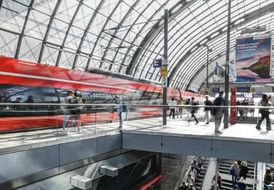Climate protection Additional information
Overview of Greenhouse gas footprint
Absolute CO₂e emissions by journeys, transport and stationary facilities / million t | 2022 | 2021 | 2020 |
Regional rail passenger transport | 1.92 | 1.99 | 2.06 |
thereof in Germany | 1.56 | 1.59 | 1.62 |
Long-distance rail passenger transport | 0.04 | 0.04 | 0.04 |
Bus transport | 1.39 | 1.58 | 1.50 |
thereof in Germany | 0.56 | 0.53 | 0.51 |
Rail freight transport 1) | 1.48 | 1.70 | 1.38 |
thereof in Germany | 0.87 | 0.98 | 0.92 |
Road freight transport 2) | 3.32 | 3.15 | 2.07 |
Air freight 3) | 6.92 | 7.07 | 5.45 |
Ocean freight 3) | 1.51 | 1.56 | 1.92 |
Other transport 4) | 0.11 | 0.11 | 0.11 |
Stationary facilities | 1.23 | 1.32 | 1.46 |
Total | 17.92 | 18.52 | 15.99 |
Well-to-wheel (WTW), Scopes 1 –3.
We calculate greenhouse gas emissions using the financial control approach as per the Greenhouse Gas Protocol. We report Scope 2 emissions according to market-based approach and we report significant transport-related emissions (category 3.4 in accordance with GHG protocol) in Scope 3 due to our business model.
1) Up to and including 2020, excluding rail freight transport from/to China by DB Cargo and DB Schenker. Double accounting may be included in 2021, meaning that the values may be slightly higher.
2) Up to and including 2020, excluding pre-carriage and onward carriage from land, air and ocean freight.
3) Since 2021, excluding pre-carriage and onward carriage.
4) DB Connect, for example, intra-company traffic.
Absolute CO₂e emissions according to Scopes 1 –3 / million t | 2022 | 2021 | 2020 |
Scope 1 emissions | 2.77 | 3.30 | 3.04 |
Share of total emissions (%) | 15.5 | 17.8 | 19.0 |
Scope 2 emissions 1) | 3.05 | 3.19 | 3.41 |
Share of total emissions (%) | 17.0 | 17.2 | 21.3 |
Scope 3 emissions 2) | 12.11 | 12.02 | 9.53 |
Share of total emissions (%) | 67.5 | 65.0 | 59.7 |
Total | 17.92 | 18.52 | 15.99 |
Up to and including 2020, excluding rail freight transport from/to China by DB Cargo and DB Schenker. Double accounting may be included in 2021, meaning that the values may be slightly higher. Upstream fuel- and energy-related emissions (Scope 3.3 as per the GHG Protocol) are reported in Scopes 1 and 2.
Individual figures are rounded and therefore may not add up.
1) Market-based approach.
2) Category 3.4 emissions according to the GHG protocol.
Our greenhouse gas footprint shows the amount of greenhouse gases that we emitted in one calendar year. It is made up of:
- our greenhouse gas emissions from the entirety of the rail and road fleet owned by DB Group, stationary facilities such as stations or workshops (Scope 1 and 2) and
- emissions from transport and transport services commissioned by DB Group (Scope 3.4 in accordance with the GHG Protocol).
The specific greenhouse gas emissions and our climate protection target are calculated on the basis of absolute greenhouse gas emissions within the limits set. They also act as a benchmark for our efficiency improvement measures and provide a basis for us to compare our performance with other companies. In 2022, absolute greenhouse gas emissions, in particular of our Europe-wide rail freight and bus services, fell significantly as a result of significant efficiency improvements in operations and a decline in volume produced. In global logistics, they are slightly below the previous year’s level.
- The Scope 2 emissions take into account market-based mechanisms, meaning that this figure includes all contractually regulated instruments for generating and trading electricity from renewable energies. In accordance with the Scope 2 guidelines of the Greenhouse Gas Protocol on dual reporting, we also report location-based Scope 2 emissions. If we take the respective national energy mixes as a basis for the reporting, the Scope 2 emissions amount to 4.36 million tons of CO₂e.
- Our subcontractors account for the largest share of our greenhouse gas emissions (Category 3.4 according to the GHG Protocol). In DB Schenker’s Preferred Carrier Program, we favor working with shipping companies and airlines that have the most modern fleets and that value sustainability. Advising our customers on climate-friendly logistics is an integral part of the service portfolio of DB Schenker and DB Cargo. We also develop strategies for decarbonizing maritime and air transport, particularly in the sector platforms of the World Economic Forum (WEF).
Methodology
Greenhouse gas accounting is based on the Group-wide final energy consumption and performance data collected and aggregated, as well as the emissions and energy factors consistently used in DB Group. The sources for the factors and methodology are DIN EN 16258, the Institute for Energy and Environmental Research Heidelberg (ifeu), the EcoTrans-IT World accounting tool, the German Environment Agency (UBA), our own calculations, as well as the GHG Protocol and ISO 14064-1. In our greenhouse gas accounting, in addition to the most important greenhouse gas in terms of volume – CO₂ – we take into account the greenhouse gases that are relevant to us, methane (CH₄) and nitrous oxide (N₂O). The global warming potential (GWP) values are based on the 5th IPCC status report (100-year GWP).


